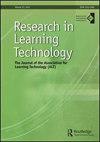The Development of an Integrated Scale of Technology Use in Physics
IF 1.2
Q2 EDUCATION & EDUCATIONAL RESEARCH
引用次数: 1
Abstract
In this study, the Integrated Scale of Technology Use in Physics (ISTUP) was developed to determine students’ frequency of technology use, their perceptions about the effects of technology use on physics interest and achievement, and their preferences of technological tools and applications in learning physics. The scale was administered two different times to 670 high school students in total who took physics courses. Exploratory and confirmatory factor analyses were conducted to validate the scale. The results of the study suggest that the ISTUP is a valid and reliable scale. Students’ frequency of technology use in learning physics corresponded to ‘sometimes’. Students perceived that technology use had slightly positive effect on their interest and achievement. Findings regarding the interrelations between students’ preference for technological tools and applications were also discussed.物理学中技术应用综合量表的开发
本研究开发了物理技术使用综合量表(ISTUP),以确定学生使用技术的频率,他们对技术使用对物理兴趣和成就的影响的看法,以及他们在学习物理时对技术工具和应用的偏好。该量表在两次不同的时间对670名参加物理课程的高中生进行了调查。进行探索性和验证性因素分析来验证量表。研究结果表明,ISTUP量表是一个有效、可靠的量表。学生在物理学习中使用科技的频率与“有时”相对应。学生认为科技的使用对他们的兴趣和成绩有轻微的积极影响。本研究亦讨论了学生对科技工具和应用的偏好之间的相互关系。
本文章由计算机程序翻译,如有差异,请以英文原文为准。
求助全文
约1分钟内获得全文
求助全文
来源期刊

Research in Learning Technology
EDUCATION & EDUCATIONAL RESEARCH-
CiteScore
6.50
自引率
0.00%
发文量
13
审稿时长
20 weeks
 求助内容:
求助内容: 应助结果提醒方式:
应助结果提醒方式:


